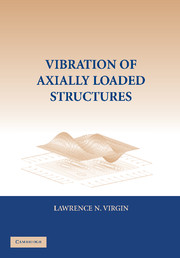Book contents
- Frontmatter
- Contents
- Foreword
- Preface
- 1 Context: The Point of Departure
- 2 Elements of Classical Mechanics
- 3 Dynamics in the Vicinity of Equilibrium
- 4 Higher-Order Systems
- 5 Discrete-Link Models
- 6 Strings, Cables, and Membranes
- 7 Continuous Struts
- 8 Other Column-Type Structures
- 9 Frames
- 10 Plates
- 11 Nondestructive Testing
- 12 Highly Deformed Structures
- 13 Suddenly Applied Loads
- 14 Harmonic Loading: Parametric Excitation
- 15 Harmonic Loading: Transverse Excitation
- 16 Nonlinear Vibration
- Index
- Plate section
2 - Elements of Classical Mechanics
Published online by Cambridge University Press: 05 May 2010
- Frontmatter
- Contents
- Foreword
- Preface
- 1 Context: The Point of Departure
- 2 Elements of Classical Mechanics
- 3 Dynamics in the Vicinity of Equilibrium
- 4 Higher-Order Systems
- 5 Discrete-Link Models
- 6 Strings, Cables, and Membranes
- 7 Continuous Struts
- 8 Other Column-Type Structures
- 9 Frames
- 10 Plates
- 11 Nondestructive Testing
- 12 Highly Deformed Structures
- 13 Suddenly Applied Loads
- 14 Harmonic Loading: Parametric Excitation
- 15 Harmonic Loading: Transverse Excitation
- 16 Nonlinear Vibration
- Index
- Plate section
Summary
Introduction
This chapter develops the theoretical basis for the derivation of governing equations of motion. It starts with Newton's second law and then uses Hamilton's principle to derive Lagrange's equations. A number of conservation laws are introduced. The theory is developed initially for a single particle and extended to systems of particles where appropriate. The emphasis is placed on building the theory relevant to the types of physical system of interest in structural dynamics. Other than the usual limitations regarding relativistic and quantum effects, we also restrict ourselves to translational (rather than rotational) systems, which is largely a matter of coordinates. The majority of problems in this book involve systems in which the forces developed during elastic deformation play a crucial role. Certain standard problems in classical mechanics, for example the central force motion leading to the two-body problem or particle scattering, are not relevant here and are not considered. We shall see the important role played by energy methods in studying the dynamics of structures. Classical mechanics has a long history and in-depth treatment of the subject can be found in Goldstein, Whittaker, and Synge and Griffith and, of course, going back to the early developments of Newton, Euler, and Lagrange.
Newton's Second Law
The natural starting point in any text covering an aspect of classical mechanics are Newton's laws of motion.
- Type
- Chapter
- Information
- Vibration of Axially-Loaded Structures , pp. 8 - 21Publisher: Cambridge University PressPrint publication year: 2007



